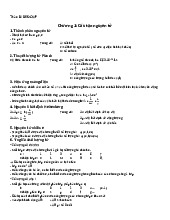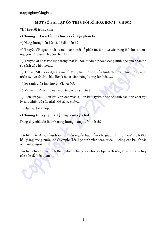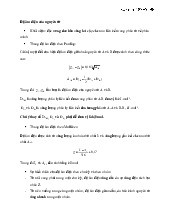



















Preview text:
CHƯƠNG I - CẤU TẠO NGUYÊN TỬ 1 Democritus (Greece, 4th Century BC) ⚫First atomic theory ⚫Atom (indivisible). Atoms & Molecules D. History ~400 BC - Democritus suggested the existence of atoms
66 AD - Peter wrote: “but the
day of the Lord will come like a
thief, in which the heavens will pass away with a roar and the
elements will be destroyed with
intense heat, and the earth and
its works will be burned up.” From New Testament, 2 Peter 3:10
1783 - Antoine Lavoisier found that matter is not created nor destroyed in a chemical
reaction. Known as “father of modern chemistry.” Atoms &Molecules D. History 1803 - John Dalton proposed that matter is made up of tiny atoms; that atoms of the same element are alike; and that atoms combine in definite ratios to form compounds. This set aside false idea promoted by Aristotle 2000 years earlier that matter was continuous.
Dalton’s Atomic Theory (1808)
1. Elements are composed of extremely small
particles called atoms. All atoms of a given
element are identical, having the same size,
mass and chemical properties. The atoms of one
element are different from the atoms of all other elements.
2. Compounds are composed of atoms of more
than one element. The relative number of atoms
of each element in a given compound is always the same.
3. Chemical reactions only involve the rearrangement
of atoms. Atoms are not created or destroyed in chemical reactions. 2 16 X + 8 Y 8 X Y 2
I. Atoms & Molecules D. History
▪ 1879 - William Crookes developed
the “ray tube” which later allowed us to view electron beams
I. Atoms & Molecules D. History
⚫ 1897 – Joseph Thomson used the cathode-ray tube and
discovered the electron.
J.J. Thomson, measured charge/mass of e- (1906 Nobel Prize in Physics)
I. Atoms & Molecules D. History
⚫ 1886 - Eugene Goldstein demonstrated existence of + particles, protons.
These particles later found to have a charge of +1 (1.60x10-19 coulombs)
and a mass of 1.67x10-24 g (a mass of 1.00 AMU).
⚫ 1909 - Robert Millikan determined mass (9.11x10-28 g; ~1800 less than
proton) and charge (-1 or -1.60x10-19 coulombs) of an electron. Measured mass of e- (1923 Nobel Prize in Physics)
e- charge = -1.60 x 10-19 C
Thomson’s charge/mass of e- = -1.76 x 108 C/g
e- mass = 9.10 x 10-28 g
I. Atoms & Molecules D. History 1911
- Ernest Rutherford (a New
Zealand physicist) demonstrated the
nuclear nature of the atom in which the
empty space is 10,000 to 100,000 times
larger than the size of the nucleus. Rutherford Experiment (1902) (Uranium compound)
Shown to be incorrect by Rutherford’s experiments
(1908 Nobel Prize in Chemistry)
particle velocity ~ 1.4 x 107 m/s (~5% speed of light)
1. atoms positive charge is concentrated in the nucleus
2. proton (p) has opposite (+) charge of electron (-)
3. mass of p is 1840 x mass of e- (1.67 x 10-24 g) Rutherford’s Model of the Atom
atomic radius ~ 100 pm = 1 x 10-10 m
nuclear radius ~ 5 x 10-3 pm = 5 x 10-15 m
I. Atoms & Molecules D. History 1932 -
James Chadwick demonstrated the
existence of the neutron which has no charge and
about the same mass as the proton (1.00 AMU). -
Why do you think that it took longer to
uncover the neutron than either the electron or proton? Chadwick’s Experiment (1932) H atoms - 1 p; He atoms - 2 p mass He/mass H should = 2 measured mass He/mass H = 4 + 9Be 1n + 12C + energy
neutron (n) is neutral (charge = 0)
n mass ~ p mass = 1.67 x 10-24 g I. Më ®Çu
1. C¸c h¹t c¬ b¶n t¹o thµnh nguyªn tö
•Proton (p) : tích điện dương
•Notron(n) : kh«ng mang ®iÖn
•Electron (e): tÝch ®iÖn ©m, m = 9,1. 10-31 kg , e
Trong 1 nguyên tử số e = số p → trung hòa về điện 20




